
Richard Evelyn Byrd Jr. was an American naval officer and explorer. He was a recipient of the Medal of Honor, the highest honor for valor given by the United States, and was a pioneering American aviator, polar explorer, and organizer of polar logistics. Aircraft flights in which he served as a navigator and expedition leader crossed the Atlantic Ocean, a segment of the Arctic Ocean, and a segment of the Antarctic Plateau. Byrd said that his expeditions had been the first to reach both the North Pole and the South Pole by air. His belief to have reached the North Pole is disputed. He is also known for discovering Mount Sidley, the largest dormant volcano in Antarctica.

The Distinguished Flying Cross (DFC) is a military decoration of the United States Armed Forces. The medal was established on July 2, 1926, and is currently awarded to any persons who, after April 6, 1917, distinguish themselves by single acts of heroism or extraordinary achievement while participating in aerial flight. Both heroism and extraordinary achievement are entirely distinctive, involving operations that are not routine. The medal may be awarded to friendly foreign military members in ranks equivalent to U.S. Pay Grade of O-6 and below, in actual combat in support operations.

The NC-4 is a Curtiss NC flying boat that was the first aircraft to fly across the Atlantic Ocean, albeit not non-stop. The NC designation was derived from the collaborative efforts of the Navy (N) and Curtiss (C). The NC series flying boats were designed to meet wartime needs, and after the end of World War I they were sent overseas to validate the design concept.

Robert Lee "Hoot" Gibson, , is a former American naval officer and aviator, test pilot, and aeronautical engineer. A retired NASA astronaut, he also served as Chief of the Astronaut Office from 1992 to 1994. Today Gibson is active as a professional pilot, racing regularly at the annual Reno Air Races. He was inducted into the U.S. Astronaut Hall of Fame in 2003 and the National Aviation Hall of Fame in 2013, and has received several military decorations throughout his career.
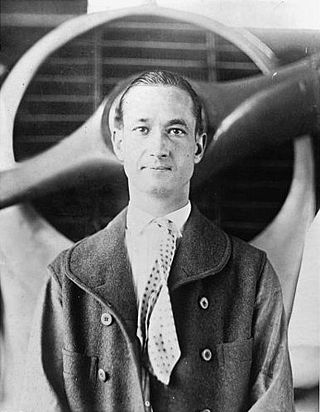
Frank Wilbur "Spig" Wead was a U.S. Navy aviator who helped promote United States Naval aviation from its inception through World War II. Commander Wead was a recognized authority on early aviation. Following a crippling spinal injury in 1926, Wead was placed on the retired list. In the 1930s, he became a screenwriter, becoming involved in more than 30 movies. He also published several books, short stories and magazine articles. During World War II, he returned to active duty. He initially worked in a planning role, but later undertook sea duty in the Pacific, where he saw action against the Japanese in 1943–44 before being placed on the retired list in mid-1945.

The Gold Lifesaving Medal and Silver Lifesaving Medal are U.S. decorations issued by the United States Coast Guard. The awards were established by Act of Congress, 20 June 1874; later authorized by 14 U.S.C. § 500. These decorations are two of the oldest medals in the United States and were originally established at the Department of Treasury as Lifesaving Medals First and Second Class. The Department of the Treasury initially gave the award, but today the United States Coast Guard awards it through the Department of Homeland Security. They are not classified as military decorations, and may be awarded to any person.

The Curtiss NC was a flying boat built by Curtiss Aeroplane and Motor Company and used by the United States Navy from 1918 through the early 1920s. Ten of these aircraft were built, the most famous of which is the NC-4, the first airplane to make a transatlantic flight. The NC-4 is preserved in the National Museum of Naval Aviation, at NAS Pensacola, Florida.

Albert Cushing Read, Sr. was an aviator and Rear Admiral in the United States Navy. He and his crew made the first transatlantic flight in the NC-4, a Curtiss NC flying boat.
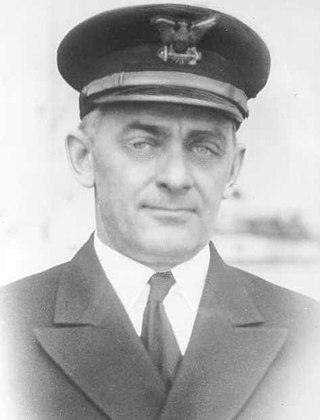
Elmer "Archie" Fowler Stone was a United States naval aviator and a commander in the United States Coast Guard.

John Henry Towers CBE was a highly decorated United States Navy four-star admiral and pioneer naval aviator. He made important contributions to the technical and organizational development of naval aviation from its beginnings, eventually serving as Chief of the Bureau of Aeronautics (1939–1942). He commanded carrier task forces during World War II, and retired in December 1947. He and Marc Mitscher were the only early Naval Aviation pioneers to survive the hazards of early flight to remain with naval aviation throughout their careers. Towers spent his last years supporting aeronautical research and advising the aviation industry.
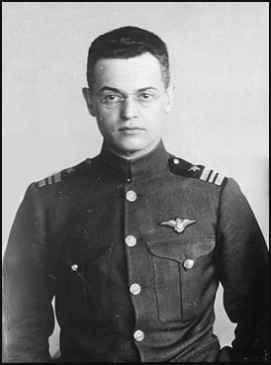
Lieutenant Commander Godfrey de Courcelles Chevalier, USN was a pioneering naval aviator of the United States Navy of World War I and the early 1920s.

William Merrill Corry Jr. was a lieutenant commander in the United States Navy during World War I and a recipient of the Medal of Honor.

Theodore Gordon Ellyson, USN, nicknamed "Spuds", was the first United States Navy officer designated as an aviator. Ellyson served in the experimental development of aviation in the years before and after World War I. He also spent several years before the war as part of the Navy's new submarine service. A recipient of the Navy Cross for his antisubmarine service in World War I, Ellyson died in 1928 when his aircraft crashed over the Chesapeake Bay.

A Weapon Systems Officer (WSO), nicknamed "Wizzo", is an air flight officer directly involved in all air operations and weapon systems of a military aircraft.
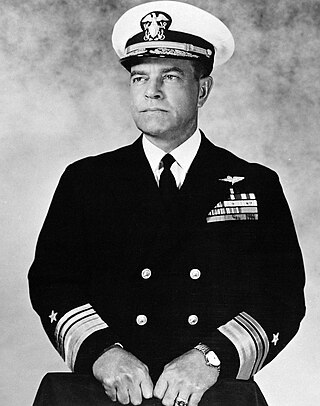
Patrick Nieson Lynch Bellinger CBE was a highly decorated officer in the United States Navy with the rank of Vice Admiral. A Naval aviator and a naval aviation pioneer, he participated in the Trans-Atlantic flight from Newfoundland to Azores in May 1919 and was decorated with Navy Cross, the United States military's second-highest decoration awarded for valor.

Holden Chester Richardson was a decorated officer in the United States Navy with the rank of captain. He is most noted as a pioneer in United States naval aviation.

James Henry Flatley III, is a retired rear admiral in the United States Navy. A naval aviator, fighter pilot, and test pilot, he is the son of Vice Admiral James H. Flatley.
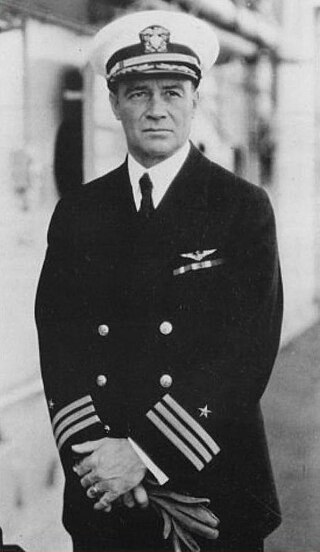
Kenneth Whiting was a United States Navy officer who was a pioneer in submarines and is best known for his lengthy career as a pioneering naval aviator. During World War I, he commanded the first American military force to arrive in Europe for combat. After the war, he was instrumental in development of the aircraft carrier in the United States, where he sometimes is known as the U.S. Navy's "father of the aircraft carrier." He was involved in some way in the design or construction of five of the first six U.S. Navy aircraft carriers, and served as acting commanding officer of the first carrier to enter U.S. Navy service and as executive officer of the first two American carriers. In the earliest days of the U.S. Navy's development of an aircraft carrier force, he led many shipboard innovations still in use aboard carriers today.

Herbert Charles Rodd was a United States Naval Aviator. He served as the radio officer on the first successful transatlantic flight by the Curtiss NC-4 in May 1919 and later helped set additional world records for flight payload, duration and speed.

David Hugh McCulloch was an early American aviator who worked with Glenn Curtiss from 1912. Curtiss was a contemporary and competitor to the Wright brothers, Wilbur and Orville, who had made the first flights at Kitty Hawk in 1903. Curtiss won the world's first air race at Reims in France in August 1909, and was now becoming the driving force in American aviation. McCulloch's early work with Curtiss consisted of demonstrating, training and selling Curtiss planes and participating in early developments of flight. He trained the First Yale Unit, and in two consecutive days in 1917, he and several of his pupils from the First Yale Unit made flights that convinced the Navy to bring aircraft aboard ships. Later, McCulloch was co-pilot with Holden C. Richardson and flight commander John Henry Towers of the NC-3, the leader of the three Navy flying boats making the first flight across the Atlantic Ocean.




















